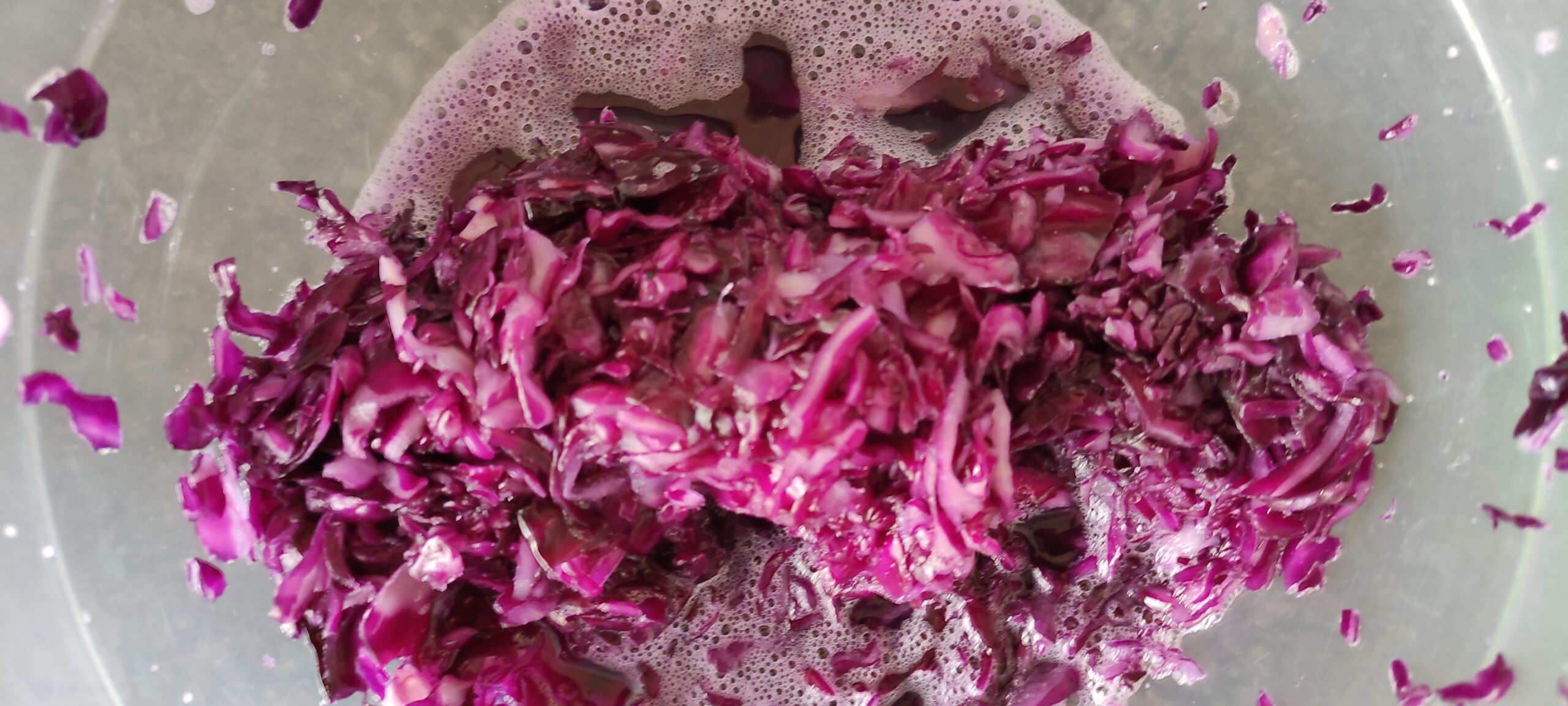Fermented red cabbage

Some years ago I heard a wonderful interview with Sandor Katz, the fermentation guru from the USA, on BBC Radio 3's Food Programme. I couldn't quite believe my ears: fermentation was really that easy? I decided to give it a go!

Sandor Katz delivers a fermentation workshop in 2015
How does it work? It's magic. Well, kind of. Anaerobic fermentation (fermentation by microbes on the cabbage's surface that takes place in the absence of air) produces lactic acid (which the microbes love...and predatory bacteria and fungi hate).
Why bother to ferment things? Those little microbes are excellent for your gut/biome health. It's also an excellent way of preserving things you don't eat a lot of (I'm hard pressed to finish even a small red cabbage on my own).
Why red cabbage? Red cabbage is an "indicator" like litmus paper, turning bluer in an alkaline environment, and pinker in an acid one. As such, it is a great vegetable for a beginner to start off with as it gives you visual proof of what is happening, but feel free to use a white cabbage if you prefer.
What does it taste like? Like tangy cabbage, and delicious, sometimes faintly nutty.
What is the texture like? This very much depends on if you chop the cabbage small and how you rub in the sea salt. Rubbing it in vigorously, and crushing the cabbage with your palms (as I did this time) produces a far softer product (which I prefer) than if you gently massage it in with your fingertips. Doing that will produce a result with more of a bite...which is not necessarily better, as it can on occasion feel squeaky or slimy.
What does it smell like? At the start it will smell exactly as you would expect it to: strongly of sliced, bruised cabbage. By day 4 or 5, that smell will have transformed into something quite pleasant, as will the taste.
Do I have to use sea salt? Yes, though kosher salt also works. You can't use table salt for this recipe. Table salt can contain dreadful additives such as potassium ferrocyanide, which are no good for anyone or anything except poisoning people. Do yourself a favour and make a resolution to rid yourself of table salt for ever! I use Saxa Coarse Sea Salt, which I grind myself, at nearly a third of the price of Maldon.
How long do I leave it to ferment? I'd recommend 5 days at least; maybe up to 7...and, if you like things really sour, up to 14. The great thing is, you can (and should) taste a bit each day, and decide for yourself when it is ready. Simply store it in the fridge to halt the fermentation process.
What would I use it for? A bit of fermented red cabbage makes a great side dish/condiment for a tuna pasta salad - or pop it inside a hummus- or falafel-stuffed pita (along with a bit of my cucumber salad). You may have noticed some at the back of my plate in last week's hummus recipe.
How long will it keep for? Up to four months in the fridge. Occasionally a harmless white mould may form on the surface; simply skim it off the top layer with a clean spoon.
The cabbage I'm using here weighed just over 600g. It will make two-thirds of a 1450ml tub, of the sort you see in the photos.
Ingredients
a small red cabbage
1 1/2 - 2 teaspoons sea salt per 300g of cabbage
water
Method
1.
Choose your red cabbage. For practicality's sake, you'll want one that weighs less than 750g.

2.
Chop it up finely. I used the slicing blade on my food processor for this batch. You could also grate it, as I do when making sauerkraut. Place in a large bowl, sprinkle the salt over, and start working it in by massaging it in your palms (for a softer result). Pause if your hands get tired then start again. After a couple of minutes, you can see how much liquid it generates. The more, the better, but don't stress!

3.
Push the cabbage into the liquid and leave it for an hour or so to draw off even more liquid. Now transfer it to a sealable plastic container, and add enough water to cover it by a quarter of an inch, mix well, and taste it (both the cabbage and the brine). It should be salty but not unpleasantly so; think of the brine in jars of green olives. Add more salt or water until it's perfect). Again push the cabbage down so it is submersed. Pop on the lid, and leave it to ferment at room temperature.

4.
Each morning and evening, unseal the tub and push the cabbage down with the back of a clean spoon or fork. You may need to top up the water and salt a little if it looks like it needs it. Taste it daily to see what is happening to it. By the third day, you will notice the cabbage and brine in decidedly pinker, the smell is improving, and a pleasant sourness is beginning to creep in!
NB: The cabbage should always taste pleasant and a little acidic. If at any point it does not, something may have gone wrong, and it's probably best to discard it.
When you feel it is ready, transfer your tub to the fridge. Now that it's fermented, it no longer needs the daily pressing. Magic!

Any questions? You can use the comments form at the bottom of the page.
Did you know?
You'll find recipes at the back of all the books in the Send for Octavius Guy series: